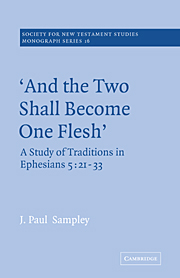Book contents
- Frontmatter
- Contents
- Dedication
- Preface
- Acknowledgments
- I Introduction of problem and perspective
- II Outline of the epistle to the Ephesians and the author's knowledge of his readers
- III Identification and study of traditional materials in 5: 21–33
- IV Three passages from the homologoumena especially related to 5: 21–33
- V Hermeneutical problems in 5: 31–2
- VI The movement of thought in 5: 21–33
- VII Detailed analysis of 5: 21–33
- VIII Concluding observations
- Bibliography
- Indexes (passages cited, authors, subjects, selected Greek words)
VII - Detailed analysis of 5: 21–33
Published online by Cambridge University Press: 29 September 2009
- Frontmatter
- Contents
- Dedication
- Preface
- Acknowledgments
- I Introduction of problem and perspective
- II Outline of the epistle to the Ephesians and the author's knowledge of his readers
- III Identification and study of traditional materials in 5: 21–33
- IV Three passages from the homologoumena especially related to 5: 21–33
- V Hermeneutical problems in 5: 31–2
- VI The movement of thought in 5: 21–33
- VII Detailed analysis of 5: 21–33
- VIII Concluding observations
- Bibliography
- Indexes (passages cited, authors, subjects, selected Greek words)
Summary
As may readily be seen from the preceding chapters, the author of Ephesians is well acquainted with a variety of traditions that circulated in the early church. He is a master of these formulations and has brought them together in almost shorthand fashion in the brief compass of 5: 21–33. As apparent from the preceding work there is no verse or part of a verse in Eph. 5: 21–33 that is devoid of traditional formulations. The author's own contribution, however, must be seen not only in his collecting these particular traditions, for any historian could do this, but also in the way in which he associates these materials one with another.
The author of Ephesians, in absence of traditions that he personally has communicated to the readers, draws heavily on traditions that he presumes to have some currency among them, possibly from their early training as catechumens within the church. The nature of catechetical instruction and liturgical practice in the life and worship of the early church is of increasing concern in NT studies. Ephesians offers a valuable source for determining the content of these catechetical and liturgical formulations.
It is the nature of written traditional materials and formulations to lend themselves to fractional or laconic treatment as a means of referring to the entire construction. When the author alludes to information he shares with his hearers or readers, he need not repeat the entire set of materials.
- Type
- Chapter
- Information
- 'And The Two Shall Become One Flesh'A Study of Traditions in Ephesians 5: 21-33, pp. 109 - 147Publisher: Cambridge University PressPrint publication year: 1971



